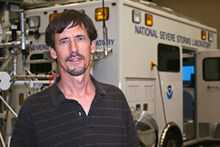Erik N. Rasmussen
| Erik Rasmussen | |
|---|---|
 | |
| Born | January 27, 1957 |
| Fields | Meteorology |
| Institutions | NSSL, CIMMS, Rasmussen Systems |
| Alma mater |
University of Oklahoma (B.S., 1980) Texas Tech University (M.S., 1982) Colorado State University (Ph.D., 1992)[1] |
| Thesis | Observational and Theoretical Study of Squall Line Evolution (1992) |
| Doctoral advisor | Steve Rutledge[1] |
| Known for | Supercell and tornadogenesis research, field project leadership |
| Notable awards | Presidential Early Career Award for Scientists and Engineers[2] |
|
Website www | |
Erik Nels Rasmussen is an American meteorologist and leading expert on mesoscale meteorology, severe convective storms, forecasting of storms, and tornadogenesis. He was the field coordinator of the first of the VORTEX projects in 1994-1995 and a lead principal investigator for VORTEX2 from 2009-2010.[3]
Rasmussen was born in Hutchinson, Kansas to James and Ilse Rasmussen in 1957. His younger brother Neal, a software engineer, is also a storm chaser and is an accomplished videographer and photographer. Erik married Lisa Walters, an atmospheric scientist and oceanographer, and a storm chaser, in 1984.
Rasmussen's undergraduate career was studying meteorology at the University of Oklahoma (OU) in Norman where he received a B.S. in 1980. Here he was introduced to field research under Howard Bluestein, chasing supercells and tornadoes, and learning about thunderstorm structure and processes. He went on to graduate school at Texas Tech University (TTU) in Lubbock where he earned a M.S. in atmospheric sciences in 1982. In grad school he developed a reputation as a particularly adept forecaster and interceptor of severe storms and tornadoes and was nicknamed "The Dryline Kid" in reference to the dry line which initiates isolated storms and attendant tornadoes.[4] His thesis was The Tulia Outbreak Storm: Mesoscale Evolution and Photogrammetric Analysis. From 1982-1984, Rasmussen pursued further postgraduate work at the University of Illinois at Urbana-Champaign (UIUC). He worked at W.A.R.N. Inc., Now Weather Inc., WeatherData Inc., and PROFS (which became the Forecast Systems Laboratory or FSL before that unit was merged into the Earth System Research Laboratory or ESRL). He finished his Ph.D. at Colorado State University (CSU) in Ft. Collins in 1992. At CSU he participated in more field work, including researching squall lines in Australia and his dissertation was titled Observational and Theoretical Study of Squall Line Evolution.[1]
Rasmussen became a research meteorologist at the National Severe Storms Laboratory (NSSL) and then the Cooperative Institute for Mesoscale Meteorological Studies (CIMMS). After the study of squall lines his interest returned to supercells from the microphysical aspects of cloud particles to mesoscale environments modulating storm behavior. He was the field commander (FC) of Project VORTEX in 1994-1995 where he worked with lead forecaster Charles A. Doswell III, participated in SUB-VORTEX and VORTEX-99, STEPS, IHOP, and served on the steering committee and was a lead principal investigator (PI) for VORTEX2 in 2009-2010.[5]
Since his college days Rasmussen was a major contributor to Storm Track magazine although by the mid-1990s his previously intense interest in storm chasing was waning. Today he does research and computer programming through his company Rasmussen Systems located near Grand Junction, Colorado. He is still supported by the National Science Foundation (NSF) and consults for NSSL, private meteorological companies, and other entities.[6]
See also
References
- ↑ 1.0 1.1 1.2 Rasmussen, Erik (2002). "Erik Rasmussen, Research Meteorologist". National Severe Storms Laboratory. Archived from the original on 2001-04-24.
- ↑ "Erik Rasmussen Named Outstanding Young Scientist" (Press release). NOAA Public Affairs. 1997-10-29. Retrieved 2014-02-19.
- ↑ NSSL VORTEX2 Quick Facts
- ↑ Williams, Jack (1997). The Weather Book (2nd ed.). New York: Vintage. pp. 132–4. ISBN 978-0679776659.
- ↑ VORTEX2
- ↑ Rasmussen, Erik. "About Rasmussen Systems LLC". Rasmussen Systems.
- Rasmussen, Erik (2007). "Severe Storms Research: Erik Rasmussen and Collaborators". CIMMS. Archived from the original on 2007-08-04. Retrieved 2014-02-19.
- Mathis, Nancy (2007). Storm Warning: The Story of a Killer Tornado. New York: Simon & Schuster. ISBN 978-0743280532.
- Davidson, Keay (1996). Twister: The Science of Tornadoes and the Making of an Adventure Movie. New York: Pocket Books. ISBN 978-0671000295.
External links
- Rasmussen Systems
- NSSL awards
- Erik N. Rasmussen at the Internet Movie Database
- J. Vesilind, Priit (Apr 2004). "Chasing Tornadoes". National Geographic.